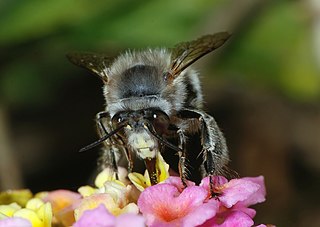
Trillium is a genus of about fifty flowering plant species in the family Melanthiaceae. Trillium species are native to temperate regions of North America and Asia, with the greatest diversity of species found in the southern Appalachian Mountains in the southeastern United States.
A hymenophore refers to the hymenium-bearing structure of a fungal fruiting body. Hymenophores can be smooth surfaces, lamellae, folds, tubes, or teeth. The term was coined by Robert Hooke in 1665.

The shiitake is an edible mushroom native to East Asia, which is cultivated and consumed around the globe. It is considered a medicinal mushroom in some forms of traditional medicine.

Pleurotus is a genus of gilled mushrooms which includes one of the most widely eaten mushrooms, P. ostreatus. Species of Pleurotus may be called oyster, abalone, or tree mushrooms, and are some of the most commonly cultivated edible mushrooms in the world. Pleurotus fungi have also been used in mycoremediation of pollutants, such as petroleum and polycyclic aromatic hydrocarbons.

The bee genus Anthophora is one of the largest in the family Apidae, with over 450 species worldwide in 14 different subgenera. They are most abundant and diverse in the Holarctic and African biogeographic regions. All species are solitary, though many nest in large aggregations. Nearly all species make nests in the soil, either in banks or in flat ground; the larvae develop in cells with waterproof linings and do not spin cocoons. Males commonly have pale white or yellow facial markings, and/or peculiarly modified leg armature and hairs. Anthophora individuals can be distinguished from the very similar genus Amegilla by the possession of an arolium between the tarsal claws.

Trillium flexipes, known as the nodding wakerobin, bent trillium, or drooping trillium, is a species of flowering plant in the family Melanthiaceae. It is found from Minnesota to Ohio, south to Tennessee, with isolated populations in New York, Pennsylvania, Alabama, and other states. It is an endangered species in Ontario and threatened in North Carolina.

Trillium cernuum is a species of flowering plant in the bunchflower family Melanthiaceae. The specific epithet cernuum means "drooping, curving forwards, facing downwards", a distinctive habit of its flower. It is commonly called nodding trillium or nodding wakerobin since the flower is invariably found nodding beneath the leaves. It is sometimes referred to as the northern nodding trillium to distinguish from Trillium rugelii, a similar nodding species native to the southern Appalachian Mountains. It is also called the whip-poor-will flower since presumably its bloom coincides with the spring arrival of the migrating bird with the same name.

Neolentinus lepideus is a basidiomycete mushroom of the genus Neolentinus, until recently also widely known as Lentinus lepideus. Common names for it include scaly sawgill, scaly lentinus and train wrecker.

Lentinus tigrinus is a mushroom in the Polyporaceae family. It is classified as nonpoisonous. It has been reported that mushrooms have significant antioxidant and antimicrobial activity.

Lentinan is a polysaccharide isolated from the fruit body of shiitake mushroom.

Cortinarius flexipes is a fungus, specifically a mushroom, a small brown species in the genus Cortinarius. It is commonly known as the Pelargonium webcap because of its unusual smell of Pelargonium.

Lentinellus is a genus of white rot, wood decay, lamellate agaric in the family Auriscalpiaceae, further characterized in part by rough-walled, amyloid spores produced on lamellae with jagged edges. Typically, thick-walled hyphae in the fruit body are in part amyloid, and frequently the taste of the mushrooms is acrid. The widespread genus has been estimated to contain 15 species. Mycologists Ronald Petersen and Karen Hughes considered 24 species in their 2004 world monograph of the genus.

Lentinus is a genus of fungi in the family Polyporaceae. The genus is widely distributed, with many species found in subtropical regions.

Panus conchatus, commonly known as the lilac oysterling, smooth panus, or conch panus, is an inedible species of mushroom that occurs throughout the Northern Hemisphere. Its fruitbodies are characterized by a smooth, lilac- or tan-colored cap, and decurrent gills. The fungus is saprophytic and fruits on the decomposing wood of a wide variety of deciduous and coniferous trees. Despite being a gilled species, phylogenetic analysis has shown it is closely related to the pored species found in the family Polyporaceae.

Lentinus sajor-caju is a species of saprophytic mushroom.
Lentinus concentricus is a species of edible mushroom in the family Polyporaceae, first found in northern Thailand and described as new to science in 2011.
Lentinus megacystidiatus is a species of edible mushroom in the family Polyporaceae, first found in northern Thailand.
The Segovellauni were a small Gallic tribe dwelling in the modern Drôme department, near the present-day city of Valence, during the Iron Age and the Roman period.

Lentinus levis is a species of edible fungus in the family Polyporaceae. It was described by Miles Joseph Berkeley and Moses Ashley Curtis in 1853 and given its current name in 1915 by William Murrill. As a saprotroph, it can be cultivated. In nature it grows in subtropical to tropical climate. It is recognized and sometimes collected as a food by Huichol people of Mexico, although they prefer eating other, less chewy mushrooms. For a long time thought to be a member of Pleurotus genus, it has been moved to genus Lentinus.















